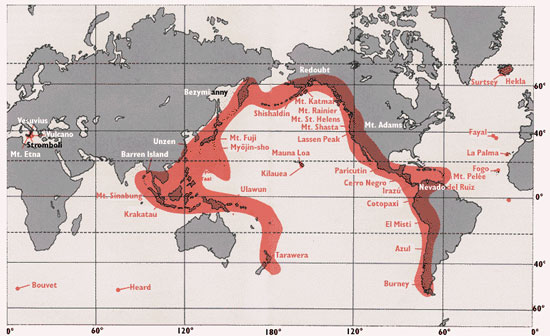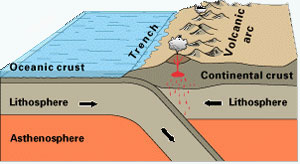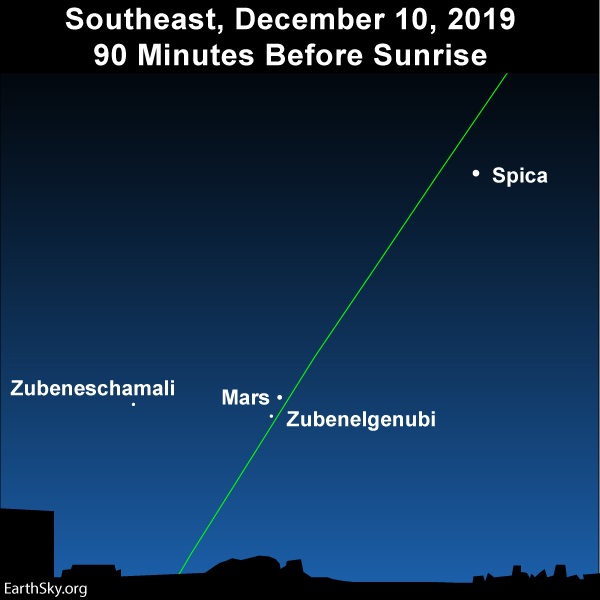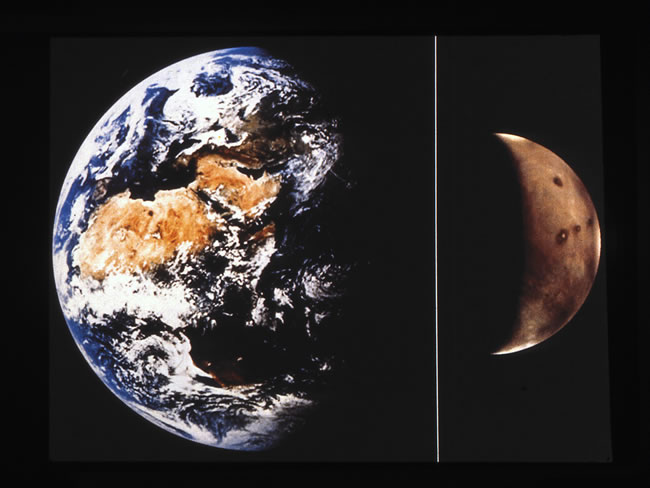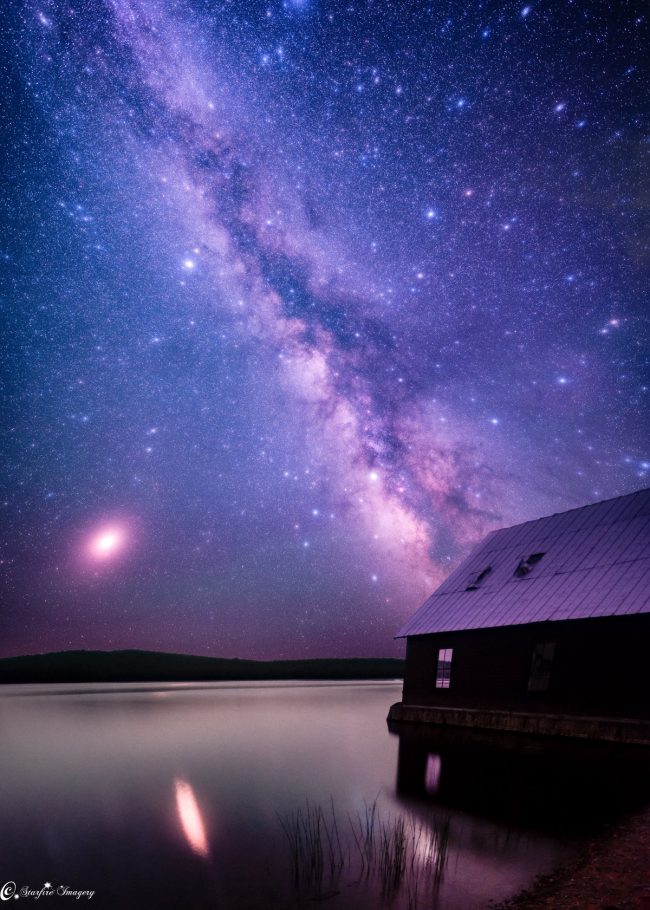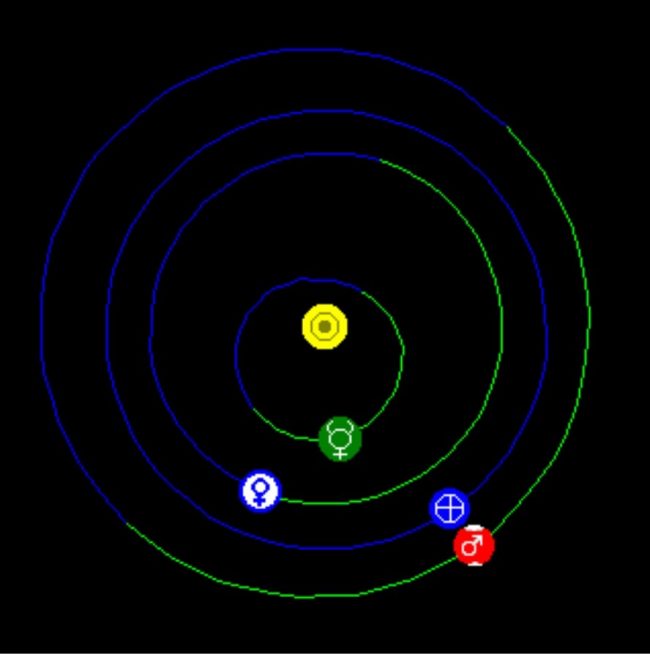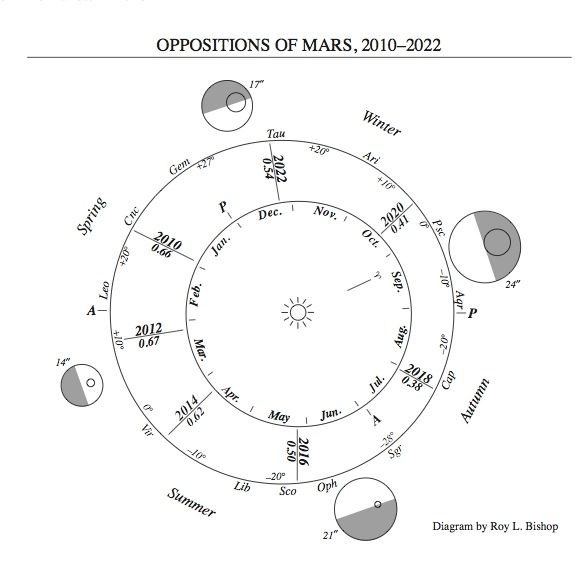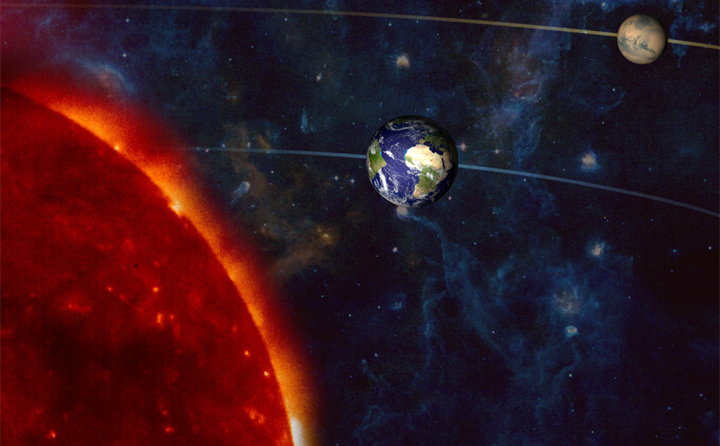
Above: Photo of the December 2018 full moon by Larry Marr
The last full moon of the year falls on December 11 or 12, 2019, depending upon your time zone. We in North America often call the December full moon the Cold Moon or Long Night Moon.
This year, the full moon comes only a few days before the expected peak night of the Geminid meteor shower. Yet, the Geminids tend to be bright, so we can expect some of these meteors to overcome the moonlit glare; moreover, the peak will come this weekend, making it easier to indulge in night owl activity.
Read more: Geminid meteors to peak this weekend
The full moon occurs on December 12, at 05:12 UTC (translate UTC to your time). At the Eastern Time Zone in the United states, that translates to 12:12 a.m. on December 12. Yet, for the rest of the country, the full moon actually takes place this evening, on December 11, 2019 – at 11:12 p.m. CST, 10:12 p.m. MST, 9:12 p.m. PST, 8:12 p.m. Alaskan Time and 7:12 p.m. Hawaiian Time.
Astronomers regard the moon as being full at the instant that it is 180 degrees opposite the sun in ecliptic longitude. However, tonight’s moon stays more or less opposite the sun all night long, so it’ll appear full all night long as well. At the vicinity of full moon, the moon pretty much rises in the east at sunset, climbs highest up for the night around midnight (midway between sunset and sunrise) and sets in the west around sunrise. In other words, around the world, expect the moon to light up the nighttime tonight from dusk till dawn.
At the instant of full moon, the elongation between the moon and sun equals 180 degrees. Visit Unitarium.com to know the present moon-sun elongation, remembering that a positive number means a waxing moon moon and a negative number a waning moon.
EarthSky 2020 lunar calendars are available! They make great gifts. Order now. Going fast!
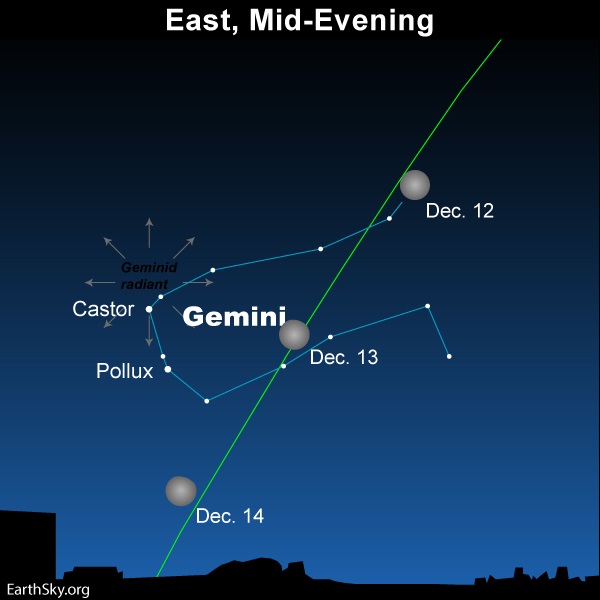
Moonlight will wash out a number of Geminids in 2019. The bright moon passes in front of the constellation Gemini, the radiant point for the annual Geminid meteor shower, on December 11, 12 and 13, 2019.
Far-southern December sun means far-northern December full moon
In December, from around the world, the sun rises and sets farthest south of due east and west for the year. For the Northern Hemisphere, these far-southern sunrises and sunsets bring short days and long nights; and in the Southern Hemisphere, these far-southern sunrises and sunsets accompany long days and short nights.
North of the Arctic Circle, the sun neither rises or sets, because the far-southern sun stays below the horizon at these far northern latitudes. However, since the full moon lies opposite the sun, the December full moon mimics the position of the far-northern June sun. So, north of the Arctic Circle, this June full moon playacts as the June midnight sun.
South of the Antarctic Circle, the far-southern December sun neither rises nor sets, as well, except that the sun stays above the horizon for 24 hours around the clock. But, then, at these far-southern latitudes, the December full moon stays beneath the horizon, like the sun in June.
Yes, the full moon assumes the sun’s position for six months hence. This December full moon now shines in front of the constellation Taurus the Bull, or where you’ll find the sun six months from now. Despite the short days and long nights of December that must be endured at our northerly latitudes, the December full moon reminds us that the long days of June will prevail once again.
Visit Heavens-Above to see the moon’s present position on the zodiac
Bottom line: At our northerly latitudes, the Cold or Long Night Moon serves as our wonderful nocturnal sun, giving us a much appreciated reprieve in the dark season of short days and long nights.
from EarthSky https://ift.tt/2P9FuOp

Above: Photo of the December 2018 full moon by Larry Marr
The last full moon of the year falls on December 11 or 12, 2019, depending upon your time zone. We in North America often call the December full moon the Cold Moon or Long Night Moon.
This year, the full moon comes only a few days before the expected peak night of the Geminid meteor shower. Yet, the Geminids tend to be bright, so we can expect some of these meteors to overcome the moonlit glare; moreover, the peak will come this weekend, making it easier to indulge in night owl activity.
Read more: Geminid meteors to peak this weekend
The full moon occurs on December 12, at 05:12 UTC (translate UTC to your time). At the Eastern Time Zone in the United states, that translates to 12:12 a.m. on December 12. Yet, for the rest of the country, the full moon actually takes place this evening, on December 11, 2019 – at 11:12 p.m. CST, 10:12 p.m. MST, 9:12 p.m. PST, 8:12 p.m. Alaskan Time and 7:12 p.m. Hawaiian Time.
Astronomers regard the moon as being full at the instant that it is 180 degrees opposite the sun in ecliptic longitude. However, tonight’s moon stays more or less opposite the sun all night long, so it’ll appear full all night long as well. At the vicinity of full moon, the moon pretty much rises in the east at sunset, climbs highest up for the night around midnight (midway between sunset and sunrise) and sets in the west around sunrise. In other words, around the world, expect the moon to light up the nighttime tonight from dusk till dawn.
At the instant of full moon, the elongation between the moon and sun equals 180 degrees. Visit Unitarium.com to know the present moon-sun elongation, remembering that a positive number means a waxing moon moon and a negative number a waning moon.
EarthSky 2020 lunar calendars are available! They make great gifts. Order now. Going fast!

Moonlight will wash out a number of Geminids in 2019. The bright moon passes in front of the constellation Gemini, the radiant point for the annual Geminid meteor shower, on December 11, 12 and 13, 2019.
Far-southern December sun means far-northern December full moon
In December, from around the world, the sun rises and sets farthest south of due east and west for the year. For the Northern Hemisphere, these far-southern sunrises and sunsets bring short days and long nights; and in the Southern Hemisphere, these far-southern sunrises and sunsets accompany long days and short nights.
North of the Arctic Circle, the sun neither rises or sets, because the far-southern sun stays below the horizon at these far northern latitudes. However, since the full moon lies opposite the sun, the December full moon mimics the position of the far-northern June sun. So, north of the Arctic Circle, this June full moon playacts as the June midnight sun.
South of the Antarctic Circle, the far-southern December sun neither rises nor sets, as well, except that the sun stays above the horizon for 24 hours around the clock. But, then, at these far-southern latitudes, the December full moon stays beneath the horizon, like the sun in June.
Yes, the full moon assumes the sun’s position for six months hence. This December full moon now shines in front of the constellation Taurus the Bull, or where you’ll find the sun six months from now. Despite the short days and long nights of December that must be endured at our northerly latitudes, the December full moon reminds us that the long days of June will prevail once again.
Visit Heavens-Above to see the moon’s present position on the zodiac
Bottom line: At our northerly latitudes, the Cold or Long Night Moon serves as our wonderful nocturnal sun, giving us a much appreciated reprieve in the dark season of short days and long nights.
from EarthSky https://ift.tt/2P9FuOp
























